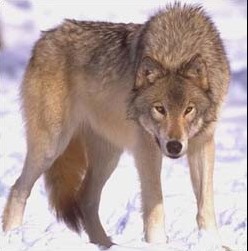| |
Aaron Miles, Manager of the Natural Resources Department, discusses the Nimíipuu use of fire (as a cultural, spiritual and biological practice) as a means for sound resource management. (Interviewed by Rodney Frey, November 2001) |
The Department of Natural Resources Management, like the Department of Fisheries Resources Management, has a vital mission in restoring, protecting and perpetuating the health and well-being of all the plant and animal populations within Nimíipuu country, as well as the cultural heritage of the Nimíipuu themselves. Among the many programs administered under the Department of Natural Resources are the Cultural Resources, Environmental Restoration and Waste Management, Forestry, Land Services, Water Resources and Wildlife divisions.
 |
The Wolves |
One of the Wildlife Program initiatives is the Wolf Recovery Project. The Tribe has been given the unique opportunity in managing the Gray wolf recovery under the Endangered Species Act. In 1995-96 thirty five Gray wolves were brought from the Alberta and British Columbia regions into Idaho. Under the stewardship of the Tribe just under 250 wolves now thrive in Idaho. While there have been fewer depredations on livestock, various non-tribal governmental agencies continue to take lethal action against these wolf packs. In one effort to help insure wolf survival, the Tribe has used an extensive network of volunteers to travel to flocks of sheep in order to set up solar powered electric fences to protect sheep at night. The Nez Perce Tribe will continue to work toward the day when the wolf will be removed from the endangered species list.
| |
Aaron Miles, Manager of the Natural Resources Department, discusses the Wolf Recovery Program. (Interviewed by Rodney Frey, November 2001) |
 |
The Wolf |
As with the salmon, because of the integral role the wolf has played in the Nimíipuu way of life, especially in a spiritual way, when the wolf or the salmon is endangered, the people themselves become endangered. The welfare of these fish and animals is a direct reflection on the heath and welfare of the Nimíipuu people.
© Nez Perce Tribe 2002
< previous |
next > |



